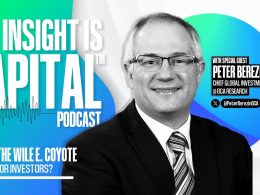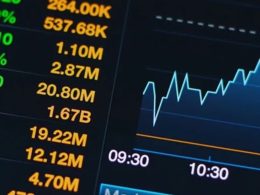by Jurrien Timmer, Director of Global Macro, Fidelity Management & Research Company
Month-end, quarter-end.
It was a busy week in London, Geneva, and The Hague, and I’m looking forward to returning to Boston tomorrow. As always, it was a pleasure to spend time with the London teams at Fidelity Management & Research and Fidelity International, with both offices across the street form each other and overlooking St Paul’s Cathedral. I like to walk as much as I can when visiting different cities, and in London I walked 20 miles in four days. Just the walk from my hotel to the office took me through Mayfair, Regent Street, Picadilly Circus, Leicester Square, Trafalgar Square, all the way to the City, It’s the best way to experience a city, and London did not disappoint. Geneva was a blur, with missed flights shortening my stay. I was there for a wedding, which took place in the Russian Orthodox Church. The entire service was conducted in Russian, complemented by a choir and two priests chanting in a deep baritone voice. It was something to behold, amplified by the fact that I couldn’t understand a word of it. The icing on the cake, of course, was my parents’ 70th anniversary, which was yesterday. Life is all about making memories, and three generations of Timmers made some good ones in Holland this weekend.
Meanwhile, in the markets, things were very quiet considering the US government has entered another shutdown. It was business as usual, even though there’s nothing usual about the state of affairs in 2025. But the markets are focused on earnings (which are accelerating), bond yields (which remain benign), monetary policy (which is turning more dovish), and sentiment (which is turning more ebullient).
Happy birthday
The cyclical bull market that was born on October 13, 2022, is about to turn three years old, and is now good for a 95% gain. That puts it slightly above average in terms of both duration and magnitude (90% over 30 months). But of course, there is nothing average about this bull market.

Scorecard
The year so far has been one in which most asset classes have advanced, the tariff tantrum in April notwithstanding. Out of the two dozen that I track, almost all of them are up over the past 52 weeks (except for the US dollar).

Secular bull
The secular bull market, by my count at least, is now 16 years old and going strong. The yellow-shaded line below is the trendline since 2009, whereas the purple-shaded one goes back 100 years. Up and to the right, with my main question being whether this one will end in a whimper (like the late 1960’s) or a bang (2000 and 1929).

Earnings & valuation
Following the estimate markdowns in April, earnings estimates have re-accelerated in recent months. That’s good to see following two years of multiple expansion. The question always is what the right price is for each dollar of earnings, and according to the market the answer is 25x for the S&P 500 cap-weighted index and 19x for the equal-weighted index.

The 2025 EPS estimate has now recovered to $262, while the 2026 and 2027 estimates have risen to $298 and $344, respectively.

1998-2000 analog
With both the cyclical and secular bull markets in full swing, driven by the AI boom and now supported by an easier Fed, the analog to the late 1990’s is unmistakable. That analog is shown below and continues to track well. Like the last three years, the 1994-2000 period produced relentless multiple expansion, until things were taken to an extreme during the blow-off phase in 1998-2000.

Exhibit A in the current analog are the non-profitable tech stocks, which have lifted out of a 3-year base. Whether this phase of ebullience becomes a bubble is something we will only know in hindsight.

Liquidity profile
The current animal spirits driving stock prices and earnings estimates higher are happening despite a deteriorating liquidity profile, driven by the Treasury replenishing its cash account at the Fed (TGA) while the Fed continues to shrink its balance sheet and the repo facility at the Fed is all but depleted. Right now the market doesn’t seem to care.


The Fed
There remain many unanswered questions hanging over the market, including whether the post-Powell Fed will become more compliant to fiscal policy. With the debate between the “status quo” Fed and a “fiscally submissive” Fed now introduced by Stephen Miran’s recent speech, the central question will come down to what constitutes a neutral policy. If neutral is inflation plus R* or 100 bps, it should be at least 3.5%. But that consensus is being challenged by a view that the neutral rate may be much lower. The market seems to be in the middle, with the forward curve now bottoming around 3% against inflation expectations around 2.5%.

Jaws
The question about a fiscally submissive Fed centers around the question of who will fund the ever-growing mountain of debt in the US and around the world. The jaws between the debt and the Fed’s Treasury holdings continues to widen. If end investors do not buy this debt, it will have to be the Fed or its proxies (the banks).

Bear steepening or financial repression.
If the Fed were to become more pliable in an era of fiscally expanding state capitalism, then yield curve control (YCC) may well become the next chapter. That may be needed to prevent the curve from bear steepening and the term premium from mean-reverting to its historical patterns. If so, Treasuries may become the next JGBs, with boring nominal returns, low volatility, and negative real returns.

Is Gold the new long bond?
Gold is seeing this movie play out from a mile away and has replaced the long bond as the bond hedge of choice. A high Sharpe Ratio with uncorrelated returns to both equities and bonds is about as good as an asset class can get. And the fact that it is difficult to own in a mutual fund and largely dismissed by institutional investors only helps sustain the rally.

The US dollar
If we are entering a regime of easy fiscal policy amplified by easy monetary policy, then it seems likely that the dollar will continue to erode as the dominant reserve currency. We only need to look back to the 1960’s to see what happened the last time.


This information is provided for educational purposes only and is not a recommendation or an offer or solicitation to buy or sell any security or for any investment advisory service. The views expressed are as of the date indicated, based on the information available at that time, and may change based on market or other conditions. Opinions discussed are those of the individual contributor, are subject to change, and do not necessarily represent the views of Fidelity. Fidelity does not assume any duty to update any of the information.
Copyright © Fidelity Management & Research Company













